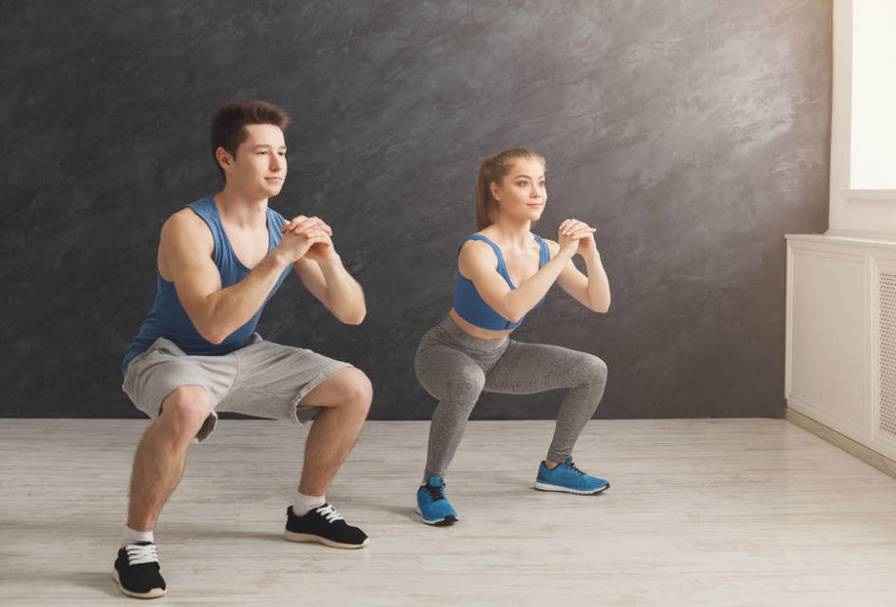1. Wall Squat (Wall Sit): Suitable for Beginners or those with Poor Muscle Endurance
Movement Breakdown: Stand half a step away from the wall, with your feet shoulder-width apart and toes pointing outwards at a 15-30 degree angle. Lean your head, back, and buttocks firmly against the wall, as if sitting on a chair. As you inhale, slowly lower your body into a squat position, bringing your knees almost to a 90-degree angle. Engage your core and shift your balance onto your heels. Hold this position for 5 seconds before gradually standing up.
Benefits: This movement offers high safety and reduces the risk of falls, helping beginners become familiar with engaging their gluteal muscle group.
2. Lateral Squat (Lateral Lunge): Suitable for Beginners
Movement Breakdown: Begin in a natural standing position. Take a step outward with your left or right foot, approximately 1.5-2 times your shoulder width. Shift your balance onto that foot, bending your knee and pushing your hips backward. Lean your body slightly forward and squat until your thigh is parallel to the ground. Keep the other leg straight and hold for 5 seconds before returning to a neutral stance.
Benefits: This movement enhances your control over body balance, flexibility, and stability while strengthening various muscle groups.
3. Sumo Squat (Sumo Deadlift): Suitable for Beginners
Movement Breakdown: Position your feet wider than shoulder-width apart and turn your toes outward. Align your knees with your toes, similar to a sumo wrestler’s stance. Perform the squat with slight variations from the traditional squat, holding the lowered position for 5-10 seconds before standing up slowly.
Benefits: This movement targets the glutes and inner thigh muscles, aiding in eliminating saddlebags and shaping a more attractive buttock contour.
4. Side Kick Squat (Side-Kicking Squat): Suitable for Beginners
Movement Breakdown: Follow the same movement as a regular squat, but when rising, shift your balance onto either your left or right foot and extend the opposite leg outward, lifting it high for a kick. Alternate leg practice.
Benefits: In addition to strength training, this movement also strengthens cardiovascular function, transforming it into an aerobic exercise.
5. Bulgarian Split Squat (Bulgarian Bag Split Squat): Suitable for Intermediate/Advanced Practitioners
Movement Breakdown: Stand with your back facing a support object, such as a bench or cabinet, that is approximately the same height as your knees. Place the top of one foot onto the support with a slightly bent knee, maintaining an upright posture with your head facing forward. Exhale as you slowly lower yourself into a squat with the other leg, keeping your knee at a 90-degree angle.
Benefits: This movement intensively trains unilateral leg muscles and reinforces hip joint flexibility.
6. Pistol Squat (One-Legged Squat): Suitable for Intermediate/Advanced Practitioners
Movement Breakdown: As the name suggests, this movement requires performing a full squat on one leg. Lift one foot off the ground and slightly shift your balancoward your standing foot. Ensure your knee is aligned forward and rely on your standing leg to squat down and stand up again, being cautious not to let your knee protrude too far forward.
Benefits: This movement significantly challenges individual balance and stability, providing intense stimulation to leg muscle groups.
7. Jumping Squat (Squat Jump): Suitable for Intermediate/Advanced Practitioners
Movement Breakdown: Use traditional squat techniques when lowering yourself, but when rising, use your leg strength to powerfully jump. Upon landing, immediately return to a squat position. This movement requires higher demands on individual cardiovascular function and movement stability.
Benefits: In addition to strengthening muscle groups, this movement greatly enhances cardiovascular function and improves fat-burning efficiency.
Post time: Nov-21-2023
